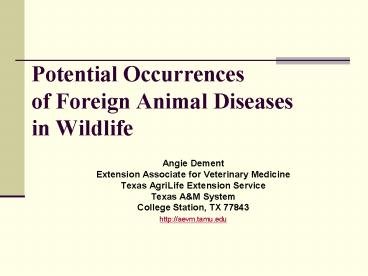Potential Occurrences of Foreign Animal Diseases in Wildlife - PowerPoint PPT Presentation
1 / 37
Title:
Potential Occurrences of Foreign Animal Diseases in Wildlife
Description:
A new disease or a new form of an old disease. Natural, accidental or intentional risks of ... Lameness (crawling on knees), ulcers, emaciation, but do recover ... – PowerPoint PPT presentation
Number of Views:38
Avg rating:3.0/5.0
Title: Potential Occurrences of Foreign Animal Diseases in Wildlife
1
Potential Occurrences of Foreign Animal Diseases
in Wildlife
- Angie Dement
- Extension Associate for Veterinary Medicine
- Texas AgriLife Extension Service
- Texas AM System
- College Station, TX 77843
- http//aevm.tamu.edu
2
U.S. Threatened by Potential Occurrences of FEAD
- Foreign Animal Diseases
- Not currently present in U.S.
- Accidental, intentional (bioterrorism) risks for
entry - Emerging Animal Diseases
- A new disease or a new form of an old disease
- Natural, accidental or intentional risks of
emergence - Commerce, mutation, environmental reasons
3
Types of Occurrences
- Natural
- Accidental
- Intentional (Bioterrorist Act)
4
Devastating Effectsof Animal Diseases
- Economic impacts
- Sociologic impacts
- Emotional impacts
- Political impacts
5
First Line of Defense
- Biosecurity
- Livestock owners
- Early detection and reporting
6
- Texas Animal Health Commission (TAHC)
- 1-800-550-8242
- 24 hours a day, 7 days a week
7
Foot and Mouth Disease
8
- Highly contagious virus
- Spreads rapidly
- People not affected
- Devastating
- Emotionally
- Economically
- Sociologically
- Politically
9
- Susceptible domestic and wildcloven-hoofed
livestock - Cattle
- Sheep
- Goats
- Domestic and feral swine
- Deer
- Llamas
10
- Transmission
- Aerosol
- wind
- Mechanical
- people, vehicles, animals
- Biological
- movement of infected animals
- uncooked or undercooked meat products
11
- If an outbreak occurs Big and Bad
- Restrictions
- Quarantines
- Eradication (Depopulation)
- Slaughter of animals
- Proper disposal
12
- FMD Outbreak in 2001 in Great Britain
- Delayed response
- 10,472 farms depopulated
- 4 million destroyed to stop disease
- 2.5 million humanely slaughtered
- Over 13 billion
13
- Increased risks for entry
- Travelers
- Meat products
- Garbage
- Bioterrorist
14
Mad Cow Disease
15
- Not contagious
- Reduced risks of entry and spread
- USDA regulations
- Feed bans
- Slaughter bans
- Import bans
16
Classical Swine Fever (Hog Cholera)
- Also known as Hog Cholera
- Affects swine and javelina
- Reportable
- Viral disease
- Eradicated from the U.S. in 1978
17
(No Transcript)
18
- Routes of exit
- Semen
- Blood
- Saliva
- Feces
- Meat
- Routes of entry
- Ingestion
- Mucous membranes
- Broken skin
- In-utero
19
- Acute form
- Fever
- Lethargic
- Off feed
- Purplish discoloration of skin
- Ears
- Legs
- Abdomen
- Death in 10-21 days
- 100 mortality in piglets
20
- Chronic form
- Unpredictable appetite
- Fever
- Diarrhea for up to 1 month
- Secondary pneumonia
- May recover only to relapse and die
- Recovery possible
- 30-70 mortality
21
- Prenatal form
- Sows
- Transient fever
- Loss of appetite
- Piglets
- Persistently infected
- 100 mortality
- Death in 6-12 months
- Mummified fetuses
- Stillbirths
22
- Fences to separate domestic and feral pigs
- Properly cook waste food before feeding to pigs
- Quarantine new pigs for at least 30 days
- Maintain good biosecurity practices
23
Anthrax
- Reportable
- Bacterial disease
- Worldwide distribution
- Endemic to U.S.
- triangle of Uvalde, Ozona, Eagle Pass, TX
- Affects numerous animal species
- Primarily domestic and wild livestock
- Zoonotic
24
- Bacterium - Bacillus anthracis
- vegetative bacteria in animal
- spore bacteria in environment
25
- Vegetative bacteria leave dead animal via
hemorrhagic exudates - mouth, nose, anus and vulva
- contain large numbers of bacteria
- Spores contaminate soil
- spores remain viable for decades
26
- Incubation period is 1-20 days
- Infections apparent after 3-7 days
27
Diagnosis
- Ruminants
- Sudden death
- Staggering
- Trembling
- Dyspnea
- Fever
- Respiratory distress
- Convulsions
- Abortions
- Bloody discharge
- FATAL
28
- Pigs
- Sudden death
- Mild, chronic infections
- Fever
- Swelling
- Enlarged lymph nodes
- Usually recover
29
- Dead animals
- Sudden death blood poisoning
- Rigor mortis absent
- Rapid decomposition extreme bloat
- Dark blood
- Enlarged spleen
- Non-clotting blood
- People
- Wound infections carbuncles
30
- Burn carcass and bedding
- Dont open carcass
- spores will not develop without oxygen
- bacteria will decompose within a few days
- Vaccination of herd required
- Quarantine of herd required for 10 daysafter
vaccination
31
Epizootic Hemorrhagic Disease (EHD)
- Endemic
- Viral
- Reportable
- Wide spread in white-tail deer
- Not contagious
- No vaccine
32
- Incubation period 5-10 days
- Viremic for 2 mos
- Biological transmission
- Biting midges
- Some gnats
- Some mosquitoes
33
- 3 Forms
- Peracute
- Fever, anorexia, respiratory distress, swelling
of tongue and conjunctiva, and die rapidly (8-36
hours) - Acute
- Extensive hemorrhages, salivation, nasal
discharge, ulcers and high mortality - Chronic
- Lameness (crawling on knees), ulcers, emaciation,
but do recover
34
- Cases found in late summer early autumn
- Usually dies down with first good cold front
35
Biosecurity
- For all diseases implement and maintain
biosecurity practices
36
(No Transcript)
37
Questions?































